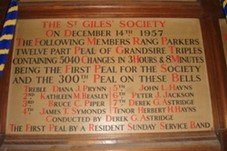
Bells
Bell Ringing at St Giles’
We have an active, friendly and capable band of ringers, the St Giles’ Society of Change Ringers.
There is a long tradition of ringing at Ashtead and local ringers and bands from further afield enjoy coming to ring the bells, either by joining us or by booking the use of the bells at another time.
Please click here to listen to our bells
Key Contacts: Ringing Master Tower Secretary
Ringing Times
Sundays: For Services 10.05 – 10.25 & 17.30 – 18.00 Thursdays: Practice Night 20.00 – 21.30
We also ring for weddings, special occasions and at other times purely for enjoyment and to further our art. If you are a ringer and are planning to join us, it is sensible to contact us beforehand in case there is a change to our normal ringing times, it happens occasionally.
What’s Involved
The primary purpose of church bells around the world is to call people to worship. Sunday service ringing is our primary focus. In most regions of the world, church bells are just swung fairly randomly, singularly or together. This can be by pulling on a rope or, these days, using electric motors.
However, in the British Isles, since the early 1700s, many church bells have been rung in an altogether different way. Our bells are rung 'full circle' by skilled individuals, meaning that we can control exactly when they strike. This is achieved by the bell ropes being attached to a large wooden wheel attached to the headstock of each bell, as in this photo.
When we ring them together, we are aiming to ring them in precise sequences and combinations called 'Methods'. This form of ringing, largely unique to the British Isles and Britain’s former colonies, requires significant coordination and concentration to do well. This is the familiar sound that people recognise up and down the country, whether it is in a rural village setting or a major state occasion with the bells of Westminster Abbey ringing out over London. It is both physically and mentally rewarding and there are always new things to learn. The intellectual reward one can get is perhaps best likened to the feeling you get when you have completed a crossword or a Sudoku! Good ringers get 'the bug'.
What Sort of People Ring?
Ringers come from all walks of life. Ringing is a great social leveller, whatever high-powered role you have in your ‘day-job’ we are all sort of equal in the ringing room and we obviously take our lead from those with the right skills and experience. Some ringers are active members of the church in other ways, some are occasional churchgoers, others not at all. We come together to support the church and community and to further our art. Typically, ringers range from the age of about 10 through to 80, or sometimes more. It makes sense to be fit, but you don’t need to be particularly strong, it’s more about technique.
Some ringers come from ‘ringing families’, i.e. one/both of their parents are/were ringers. Others come to it from already being involved in the church, or from simply hearing the bells, or looking to take up a new sociable team activity, in the same way that you might join something like a local volleyball, netball or cricket club.
We have some very experienced ringers who have been ringing since childhood and who, over 30 or 40 years or so have rung in many towers, with many ringers, and have achieved a great level of skill and experience to pass on to others. At the other end of the spectrum we have ringers who have learnt much later in life and who have not yet rung much in other towers etc. At whatever level there are always new things to learn, new goals to aim for, more ringers to meet and more neighbouring towers to visit etc.
Come and Meet Us
If you think you might like to learn to ring, or are just interested to learn more, then please get in touch so that we can arrange for you to come up the tower and see for yourself what is involved. We can show you what we do, explain more how it all works, and take you up to see the bells themselves at the top of the tower. The best time for us to do this is on our Thursday practice night. Get in touch and we can suggest a suitable time.
The St Giles’ Society of Change Ringers
The Bell Ringers of St Giles’ were formed into the above Society in 1952 by the Rector of the day. This type of arrangement is common for churches around the country with peals of bells.
The primary day-to-day objective of the Society is obviously to ring the bells for Sunday services and other special church and state occasions. The objectives of the Society are however wider than this. They place a responsibility on us to ensure the standard of ringing is kept high and that the continuity of the band is ensured through teaching new people to ring and progressing them to the stage whereby they can be an effective part of the Sunday service band.
The Society has a formally adopted set of Rules by which we organise and manage ourselves so that these objectives are met. Day-to-day however things are much simpler and less formal. We ring on Sundays, practice on Thursdays and perhaps have a beer afterwards. We ring & socialise too with other ringers in the area to various degrees.
Teaching new ringers and the furtherance and upholding of the skills needed to ring well are a major part of the responsibilities of the Ringing Master and his deputies.
The Society also owns a magnificent set of handbells specifically donated to the Society by Mrs K B Bell in 1967 in memory of her husband, Col. Malcolm Bell, a ringer at St Giles’ for many years. The Society has funded the addition of extra handbells to the original set over the years. In addition to their primary purpose in supporting the goals of the Society, they have at various times been made available to groups, linked to the ringers, for the purpose of tune ringing.
St Giles’ Bells History & Details
We know that St Giles’ had 6 bells that were cast in 1725 and that metal from three older existing bells was in part used to make them. Our current peal of 8 bells were a gift to the parish by Mary Howard, cast in 1873 and hung in a modified version of the existing wooden frame.
In 1959 the wooden frame broke. Ringing was restricted with temporary repairs. A major project by Taylors of Loughborough followed in 1961 when the bells were taken away for tuning and then re-hung with brand new fittings in a new cast-iron frame mounted on double foundation steel joists. This was a very major project that would have cost about £80,000 if done today.
The Bells were more recently overhauled in 2007 by Nicholson Engineering. This work involved new bearings, new pulleys and adjustments to the hanging radii and clapper throws of some of the bells. The Tenor was also 1/8th turned. The bells are a delight to ring. This photo shows the 3rd & 4th bells removed from their headstocks and wheels during the overhaul.
Our heaviest bell is just under 13cwt (589Kg) with a diameter of about 1.1m at its widest part. In total the 8 bells have a dead weight of approximately 2.5 tons but when they are swinging full circle, as they do when we ring them, very considerable forces are involved.
The bells were cast by Mears & Stainbank in 1873 at their Whitechapel Foundry, the foundry closed in 2017 having been in business since approx. 1570.
Peals at St Giles’
For bell ringers the term ‘Peal’ has a specific meaning, it is an extended complex performance which lasts about 3 hours. See here. Peals are easily ‘lost’ if the ringers or conductor make mistakes. Concentration is key, it is quite an achievement to successfully complete a Peal.
There have been over 440 Peals rung on the Bells. The full list can be found here.
For more details of recent Peals and Quarters then click here and search for 'Ashtead'.
Notable Peals
There have been several notable Peals over the years at St Giles’. The most recent of these was rung on Sunday, 11 November 2018 in celebration of the centenary of the cessation of hostilities of the Great War, recognising the peal rung in the same tower and the same method on 13th November 1918. This was arranged by the Ringing Master and involved other members of the band and other local ringers. Click here for the details.
A Peal had been rung at St Giles’ to mark Queen Victoria’s Diamond Jubilee in June 1897 and the Ringing Master was keen that we should mark the Diamond Jubilee of HM Queen Elizabeth II in the same way. A Peal of Yorkshire surprise Major was rung, again with the help of local ringers. Details here.
A Peal was also rung for the Queens 90th Birthday. Details here.
Rather than to mark an occasion, but more as a goal/achievement in ringing terms, a historic Peal was rung at St Giles’ on 17th March 2012. This was the first Peal of Shipway Major that had been rung for over 100 years and only the 6th Peal of the method in total. There has been no Peal of it since and it remains that there are just the 8 of us alive who have rung a peal of this including the first 2 women to do so! Details here.
To mark the 100th anniversary of the consecration of St George’s. Details here.
The first Peal of Ashtead Surprise Major (1932) is shown on this Peal Board which hangs in the tower, along with one which marks the first Peal by a resident Sunday Service band of The St Giles Society (1957).
Members of the Society, assisted by other local ringers, rang a Quarter Peal of Ashtead Surprise Major on 2nd July 2008. This was first broadcast on BBC Radio 4’s Bells on Sunday on 10th August 2008. It has been re-broadcast several times since, most recently on 3rd August 2020. You can hear the last 3 minutes of the Quarter (longer than the Radio 4 clip) here.
Other Links with Local Ringers
There are many local bell ringers in the area and towers with various numbers of bells that are hung for Change Ringing. There are also churches with fewer bells that are only able to be chimed (swung very simply, perhaps by a verger).
Practice nights are fixed locally so that they don’t clash too much. You can join other towers, other than your ‘home tower’ to gain/pass on experience and to socialise.
Monday: Epsom St Martins (10 bells), or Dorking (10), Stoke D’abernon (6)
Tuesday: Leatherhead (10), Ewell (8)
Wednesday: Epsom Common (8)
Thursday: Ashtead (8)
Ringers in the area tend to belong to one or both of the two local area ringing Societies:
The Guildford Diocesan Guild of Church Bell Ringers
The Surrey Association of Church Bell Ringers
These organisations run full programmes of additional ringing practices, meetings and social events. Their websites hold all the details as well as details of all towers & contacts for miles around!







